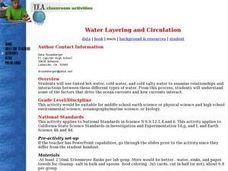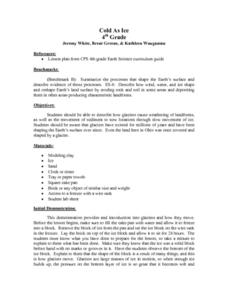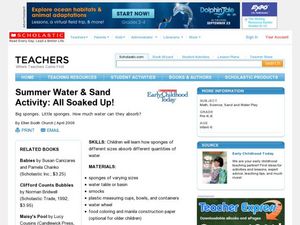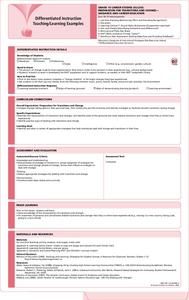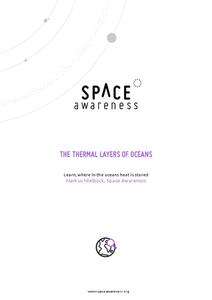Curated OER
Beach Life: Clam Dissection
Students investigate clams. In this clam life activity, students conduct an experiment where they dissect clams. Students compare anatomies of humans and clams.
Curated OER
Mixtures of Matter
Students experiment with mixtures of matter. In this matter lesson, students investigate which liquids form a solution when mixed together and which do not. Students also identify which solids can be separated from matter.
Curated OER
Solutions and Suspensions
Students explore matter by conducting an in class demonstration. In this liquid mixture lesson, students identify the difference between a solution in which a solid dissolves into liquid, and a suspension where the solid doesn't dissolve...
Curated OER
Ecological Impact of River Dams
Students investigate their environment by completing an in-class experiment. For this ecological lesson, students define the roles of dams and how electricity is created by them. Students utilize plastic jugs, sand and tap...
Curated OER
Rain and Rainbows
Students explore the weather system by analyzing water properties. In this precipitation lesson, students review weather related vocabulary terms and discuss how rainbows are created by light hitting droplets at the right time. Students...
Curated OER
Damsels and Dragons
Young scholars experiment with the perching behaviors of damsel and dragonflies. In this damsel and dragonfly lesson, students construct perches for the insects. They observe their perching behavior and their reaction to decoys of...
Curated OER
Water Layering and Circulation
Students examine relationships and interactions between different types of water. They experiment with colored water of different temperature and salinity and discuss how the results relate to real ocean currents.
Curated OER
Osmosis Investigation
Learners investigate osmosis as they determine how carrot cells respond to two different environments. They conduct the experiment, record the data, and answer discussion questions.
Curated OER
Camouflage and Protective Coloration: A Model of Natural Selection
Students study protective coloration and camouflage in animals. They create examples of each and conduct simulation-type experiments to determine which is the most effective adaptation.
Curated OER
Chemical Changes
Fourth graders examine and identify chemical and physical changes in a variety of substances. They observe a vinegar and baking soda demonstration, and a water, laundry detergent, and Epsom salt mixture demonstration. They discuss the...
Curated OER
Cold As Ice
Fourth graders investigate how glaciers cause the weathering of landforms. They observe a brick that has been placed on a frozen slab of ice, and discuss the results, comparing them to the movements of a glacier. In small groups, they...
Curated OER
Rock Cycles, Crayon Cycles
Students examine the rock cycle and the path that rocks go through to rearranged in different ways. They define key vocabulary terms, then in small groups conduct a variety of experiments using crayon shavings as simulated rocks and...
Curated OER
Get a Half-Life!: Student Worksheet
In this math/science worksheet, learners will work in pairs to conduct an experiment based on a decay function which is often used to model radioactive decay. Students will shake M & M's in a cup to rub off the M and then record...
Curated OER
Summer Water & Sand Activity: All Soaked Up!
In this lesson, Summer Water & Sand Activity: All Soaked Up!, young scholars experiment with sponges and water. Students analyze how sponges absorb water. Young scholars learn a song to sing during the lesson to help them understand...
Curated OER
What Will Rust?
For this science worksheet, students participate in an experiment about which items will rust and which ones will not. Students draw a picture of the items for 6 days and record the day, date, and time.
Curated OER
Bobbie Bear
Pupils examine how many different outfits can be made out of a given set of different colored shirts and pants. In this word problem lesson plan, students list or graph the possible results of an experiment. Pupils make a list of all...
Curated OER
Soil Buffering
High schoolers observe the pH change of an acid mixture poured over soil in a filter. Since the buffering capability of soils differs, you may want to do this experiment with several different soil types.
Curated OER
Observing The Influence Of Acid Rain On Plant Growth
Students observe one of the direct effects of acid water on plant growth. Students engage in an experiment which will take about 2 weeks. Students will understand the effect that acid rain has on plant growth.
Curated OER
Looking At Acid's Effects On Metals
Students perform an experiment that demonstrates acid rain. The chemical effect of acids on metals may take at least five days for the human eye to see, even though the reaction starts as soon as the acid contacts the metal.
Virginia Polytechnic Institute and State University
Lesson Plan: Omelet Cooking Principles
Although designed for a foods lab, the information in this resource might be just the thing for your own recipe notebook. Illustrated, step-by-step directions for making the perfect omelet, egg-citing puzzles, games, and even...
EduGAINs
Preparation for Transitions and Change— Guidance and Career Education
Every hopeful in your class has gone through some kind of life change, from parents' divorce to a death in the family to moving up into another grade. Encourage them to discuss these changes, the skills they used and acquired...
California Department of Education
I’m Ready to Work
Get ready to apply yourself! Lesson four in a series of five college and career readiness lessons introduces the basic parts of a job application. Pupils discover the necessity for good references and create a master job application for...
Space Awareness
The Thermal Layers of Oceans
How much does the sun heat up a lake or ocean? Scholars use a cup and a strong lamp to investigate the heat transfer and thermal layers in the ocean to come up with the answer. They collect data and graph it in order to better understand...
Curated OER
The Effects of Temperature on Rate
Young scholars create predictions on what they believe happen to reaction rates when temperature is raised. They use hot, cold, and room temperature water for this experiment and observe the differences. They graph their observations and...
Other popular searches
- Science Experiments
- Friction Experiments
- Water Pollution Experiments
- Life Science Experiments
- Density Experiments
- Air Pollution Experiments
- Electricity Experiments
- Egg Science Experiments
- Egg Experiments
- Chemical Change Experiments
- Rocket Experiments
- Cloud Experiments






